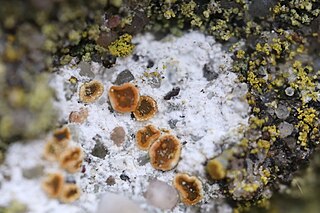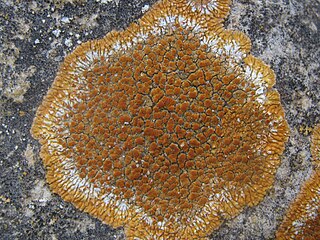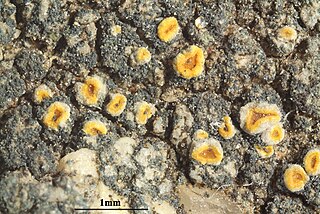Lendemeriella aureopruinosa is a species of crustose lichen in the family Teloschistaceae. Found in the Russian Far East, it was formally described as a new species in 2021 by Ivan Frolov, Jan Vondrák, Ulf Arup, Liudmila Konoreva, and Sergey Chesnokov, Lidia Yakovchenko, and Evgeny Davydov. The type specimen was collected on the banks of River Bes-Yuryakh ; here it was found growing on siliceous outcrops in a forest comprising largely birch, alder, and larch trees. The thallus of the lichen ranges in form from an inconspicuous grey film to a more well-developed crust or areoles. Its apothecia measure 0.3–0.6 mm in diameter and have a dark-orange to brick-red coloured disc. Secondary chemicals detected in the lichen include parietin, parietinic acid, emodin, teloschistin, and fallacinal. The specific epithet aureopruinosa refers to the bright gold-coloured pruina that is found on young apothecia.

Kuettlingeria is a genus of saxicolous (rock-dwelling), crustose lichens in the family Teloschistaceae. Species are characterized by a white or gray thallus and the presence of anthraquinones in the apothecial disc and true exciple, with the exception of Kuettlingeria diphyodes, which entirely lacks anthraquinones. First described by Italian botanist Trevisan in 1857, the genus includes 15 recognized species, although it is believed to be more diverse with additional unnamed species. These lichens are predominantly found in the Northern Hemisphere, particularly in the Mediterranean region, and grow on limestone and base-rich siliceous outcrops in sunlit conditions.

Variospora flavescens is a species of saxicolous (rock-dwelling), crustose lichen in the family Teloschistaceae. It is a common, widely distributed species and has been recorded in Africa, Asia, Europe, and Macaronesia.

Leproplaca cirrochroa is a widespread and common species of saxicolous (rock-dwelling), crustose lichen in the family Teloschistaceae. It grows up to 5 cm across, featuring a placodioid thallus with narrow, finger-like lobes that adhere closely to the surface, showing intricate division and ranging in colour from dirty orange to brownish orange, often with paler, pruinose orange ends.

Kuettlingeria albolutescens is a species of saxicolous (rock-dwelling), crustose lichen in the family Teloschistaceae. It occurs in Europe and Western Asia.
Caloplaca sterilis is a corticolous (bark-dwelling), crustose lichen belonging to the family Teloschistaceae, described in 2011. It is primarily found in steppe and sand dune habitats in the Black Sea region, and has been recorded from Bulgaria, Romania, southwest Russia, and Ukraine. Caloplaca sterilis is characterised by tiny squamules/areoles with contrasting pale greyish-green to greenish soredia. It is easily overlooked and challenging to identify when completely sorediate and sterile, especially as its soredia do not contain the typical Sedifolia-grey pigment.
Lecidea lygommella is a species of saxicolous (rock-dwelling), crustose lichen in the family Lecideaceae. It spreads up to 7 cm wide with a thin thallus varying in colour from whitish and pale grey to rusty red-brown, featuring areolate surfaces with irregularly shaped areoles. Its fruiting bodies range from slightly embedded to sitting atop the thallus and black, flat to slightly convex apothecial discs. Unlike its lookalike Lecidea lygomma, L. lygommella does not produce any secondary chemicals. It is found in New South Wales and Victoria, Australia, where it grows on rocks in alpine areas.
Pyrenodesmia micromontana is a species of saxicolous (rock-dwelling), crustose lichen in the family Teloschistaceae. Found in the Orenburg region of Russia, this species prefers to grow on lime-rich schist and sandstone boulders and pebbles in scrubs and steppes.
Caloplaca nothoholocarpa is a species of saxicolous (rock-dwelling), crustose lichen in the family Teloschistaceae. It is found in Chile.
Caloplaca sol is a species of saxicolous (rock-dwelling), crustose lichen in the family Teloschistaceae. It is found on limestone and basic siliceous rocks along the southern and western shores of Great Britain.
Pyrenodesmia micromarina is a species of saxicolous (rock-dwelling), crustose lichen in the family Teloschistaceae. It is found in the Eastern Mediterranean, specifically along the coasts of the Black Sea and the Sea of Marmara in Russia, Turkey, and Ukraine. It grows on coastal rocks and occasionally concrete, often in Mediterranean scrub vegetation.

Flavoplaca austrocitrina is a species of saxicolous (rock-dwelling), crustose lichen in the family Teloschistaceae. It is widely distributed in Europe, and has also been recorded in South America.
Flavoplaca arcisproxima is a species of saxicolous (rock-dwelling), crustose lichen in the family Teloschistaceae. It is found primarily in the coastal regions of the Crimean Peninsula and the eastern Mediterranean, particularly in Crete, Greece.

Variospora thallincola is a species of saxicolous (rock-dwelling), crustose lichen in the family Teloschistaceae.

Kuettlingeria soralifera is a saxicolous (rock-dwelling), crustose lichen species in the family Teloschistaceae, first described in 2006. It is similar to Kuettlingeria xerica but distinguished by the presence of soredia on its thallus.

Kuettlingeria teicholyta is a species of saxicolous (rock-dwelling), crustose lichen in the family Teloschistaceae, and the type species of the genus Kuettlingeria. It is a widely distributed lichen, having been recorded from Africa, Asia, and Europe.

Kuettlingeria neotaurica is a species of saxicolous (rock-dwelling), crustose lichen in the family Teloschistaceae.

Pyrenodesmia variabilis is a species of saxicolous (rock-dwelling), crustose lichen in the family Teloschistaceae. Characteristics of the species include its dark, areolate thallus, and its dark, sessile (stalkless) apothecia. It occurs on nutrient-rich limestone surfaces in Northern Europe, North America, Central America, and Asia.
Kuettlingeria furax is a species of lichenicolous (lichen-dwelling) crustose lichen in the family Teloschistaceae. It was first formally described as a new species in 1983 by José María Egea Fernández and Xavier Llimona; they classified it in the genus Caloplaca. The type specimen of this lichen was discovered in the eastern part of the Sierra Morena mountains in Albacete, Spain. It was found growing parasitically on other lichens in the genus Aspicilia, which are found on silica-rich surfaces.
Xanthocarpia diffusa is a species of saxicolous (rock-dwelling) crustose lichen in the family Teloschistaceae. First described in 2011 from coastal rocks in Georgia, it is characterised by its yellow to greyish thallus with distinctive diffuse margins often bordered by a pale prothallus. The species primarily occurs along coastal areas of the Black Sea region, with some isolated populations in the Mediterranean region, where it grows on damp siliceous rocks, particularly around seepage zones and in areas exposed to sea spray. Though initially described in the genus Caloplaca, molecular phylogenetics studies led to its transfer to Xanthocarpia in 2013.










